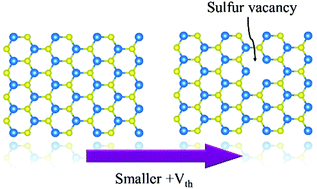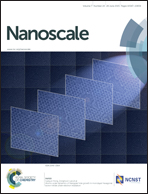Tuning the threshold voltage of MoS2 field-effect transistors via surface treatment†
Abstract
Controlling the threshold voltage (Vth) of a field-effect transistor is important for realizing robust logic circuits. Here, we report a facile approach to achieve bidirectional Vth tuning of molybdenum disulfide (MoS2) field-effect transistors. By increasing and decreasing the amount of sulfur vacancies in the MoS2 surface, the Vth of MoS2 transistors can be left- and right-shifted, respectively. Transistors fabricated on perfect MoS2 flakes are found to exhibit a two-fold enhancement in mobility and a very positive Vth (18.5 ± 7.5 V). More importantly, our elegant hydrogen treatment is able to tune the large Vth to a small value (∼0 V) without any performance degradation simply by reducing the atomic ratio of S : Mo slightly; in other words, it creates a certain amount of sulfur vacancies in the MoS2 surface, which generate defect states in the band gap of MoS2 that mediates conduction of a MoS2 transistor in the subthreshold regime. First-principles calculations further indicate that the defect band's edge and width can be tuned according to the vacancy density. This work not only demonstrates for the first time the ease of tuning the Vth of MoS2 transistors, but also offers a process technology solution that is critical for further development of MoS2 as a mainstream electronic material.


 Please wait while we load your content...
Please wait while we load your content...